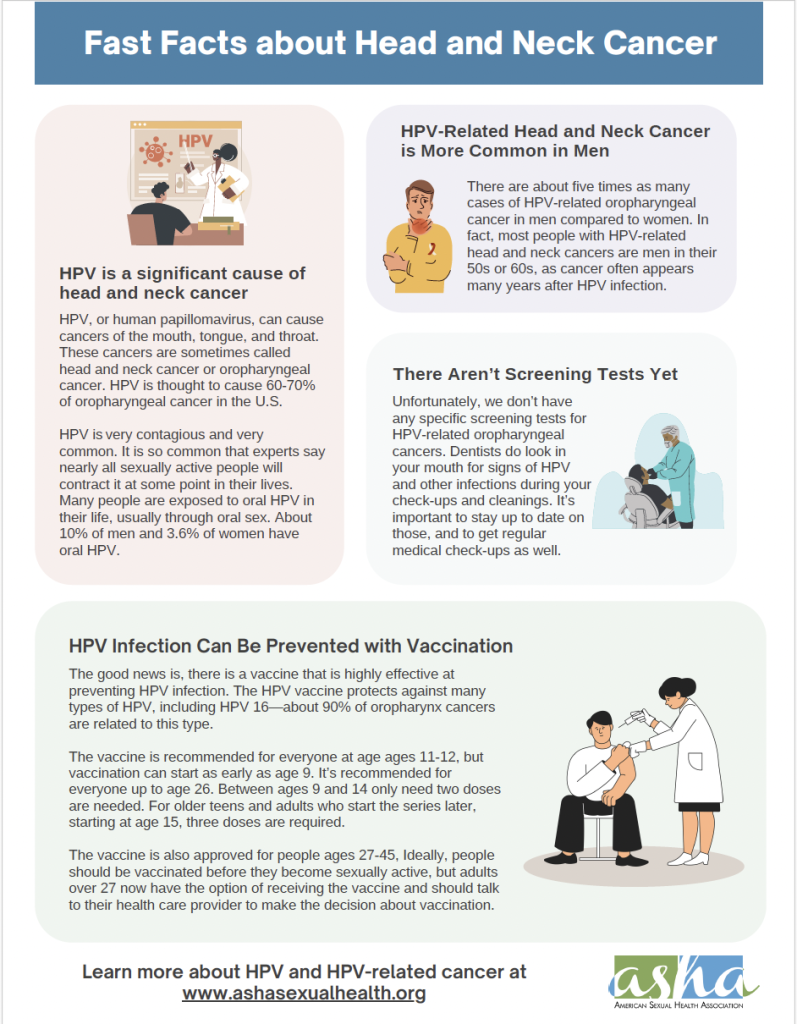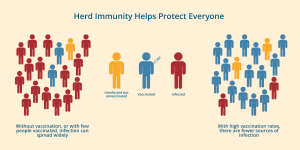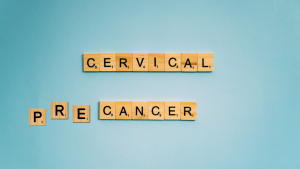You have probably heard that HPV can cause cervical cancer. But did you know that it can also cause cancers of the mouth, tongue, and throat? These cancers—sometimes called head and neck cancer or oropharyngeal cancer—often appear years or even decades after HPV infection. In fact, most people with HPV-related head and neck cancers are men in their 50s or 60s.
Here are some of the things you need to know about the connection between HPV and oropharyngeal cancer.
What is HPV?
There are over 150 different types of human papillomavirus, or HPV. About 40 of them are spread during sexual activity and are known to infect the genitals, anus, mouth, or throat.
HPV is spread by direct, skin-to-skin contact. It is commonly spread during vaginal, anal, and oral sex but can be spread during any sexual encounter even without penetration.
How common is HPV?
HPV is very contagious and very common. It is so common that experts say nearly all sexually active people will contract it at some point in their lives. About 79 million people are thought to have an active HPV infection at any given time.
Many people are exposed to oral HPV in their life, usually through oral sex. About 10% of men and 3.6% of women have oral HPV. Oral HPV infection is more common with older age.
What are the symptoms of HPV?
Most people have no symptoms. In fact, in most cases the body clears the HPV infection naturally without a person ever knowing they had it. But some HPV infections are persistent.
Some types of HPV can cause genital warts and other types can cause cancer, including cancer of the cervix, vulva, vagina, penis or anus, as well as cancer of the mouth, tongue, or throat.
Is all cancer of the head and neck caused by HPV?
No. HPV causes cancers in the oropharynx which is the name for the back of the throat including the base of the tongue and the tonsils. HPV is thought to cause 60-70% of oropharyngeal cancer in this country. Cancer in this part of the throat can also be caused by other things, most notably smoking.
There are other types of head and neck cancers—like cancer of the larynx, lip, nose, or salivary glands—that are not caused by HPV.
How long does it take for HPV-related oropharyngeal cancer to develop?
It can take many years for cancer to form. The back of the throat has a lot of uneven surfaces and crevices where the virus can lodge. HPV can stay dormant for years before causing cancer. We also know that these cancers can be slow-growing and can go unnoticed for a long time.
If you or your partner is diagnosed with an HPV-related cancer, you should know that they may have gotten HPV years ago or even decades ago. There is no reason to suspect that someone cheated.
What are the signs and symptoms of HPV-related oropharyngeal cancer?
The most common symptom is a lump in the neck that doesn’t go away. This usually means that the cancer has spread to a lymph node.
Other symptoms include a sore throat lasting more than a few weeks, trouble swallowing, voice changes that sound hoarse or raspy, and ear pain.
If you have any of these symptoms, see a health care provider.
Can I get tested to see if I have oral HPV or cancer of the mouth, tongue, or throat?
One of the reasons cervical cancer rates have dropped is because we’re able to screen for HPV and pre-cancerous changes to the cervix. Unfortunately, we don’t have any specific screening tests for HPV or oropharyngeal cancers.
Dentists do look in your mouth for signs of HPV and other infections during your regular check- ups and cleanings. It’s important to stay up to date on those, and to get regular medical check-ups as well.
Is there anything I can do to prevent HPV and HPV-related cancer?
Yes. The HPV vaccine protects against the high-risk types of HPV that are most likely to cause cervical cancer and other HPV-related cancers including oropharyngeal cancer.
The vaccine is approved for anyone ages 9 to 45. It is recommended that young people get the vaccine as part of the routine immunizations they get around age 11. This way they can be fully vaccinated before they become sexually active and might be exposed to HPV. If you get the vaccine before age 15, you only need two doses.
Anyone under 26 who hasn’t gotten the vaccine should do so (though if you’re older than 15, you will need three doses). People who are between 27 and 45 can talk to their health care provider to decide whether the vaccine makes sense for them. Getting vaccinated is the most important prevention method.
Using condoms or dental dams during vaginal, anal, or oral sex can also help reduce the spread of HPV. Avoiding tobacco and limiting alcohol intake may also help reduce the risk.
It’s also important to pay attention to your body and your symptoms. Don’t ignore a lump in your throat or a persistent ear pain. If it is cancer, the earlier you find it, the easier it is to treat.








